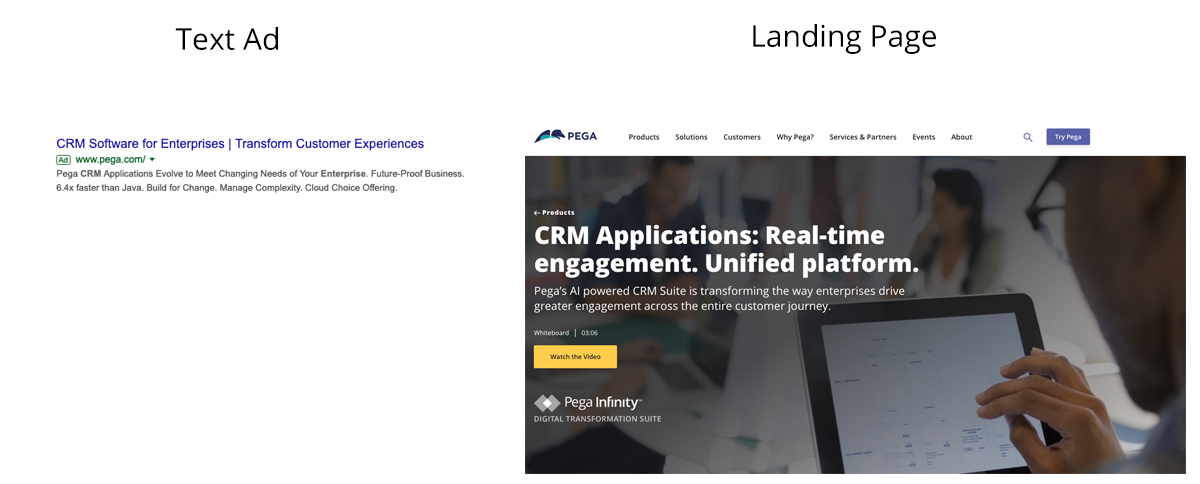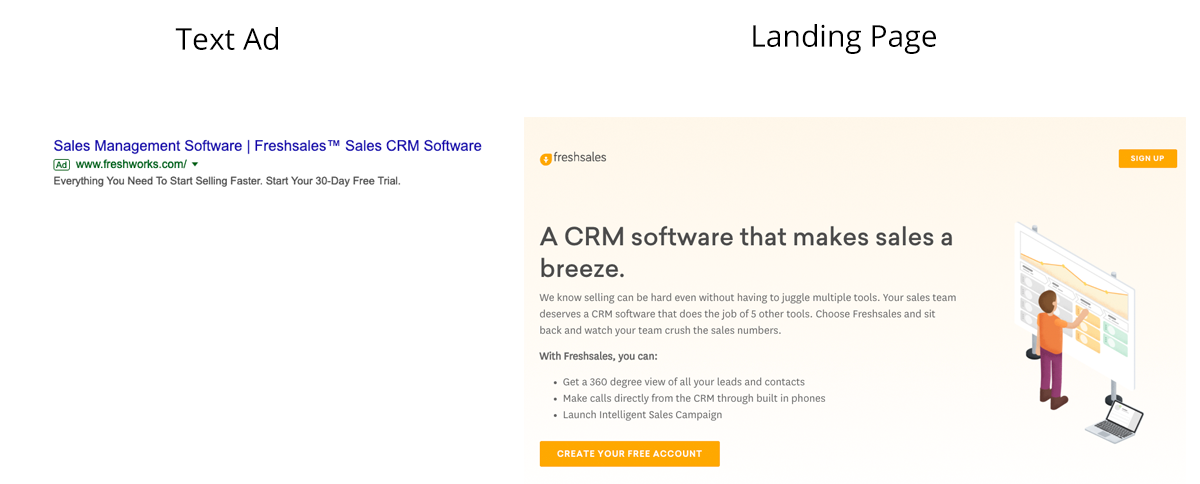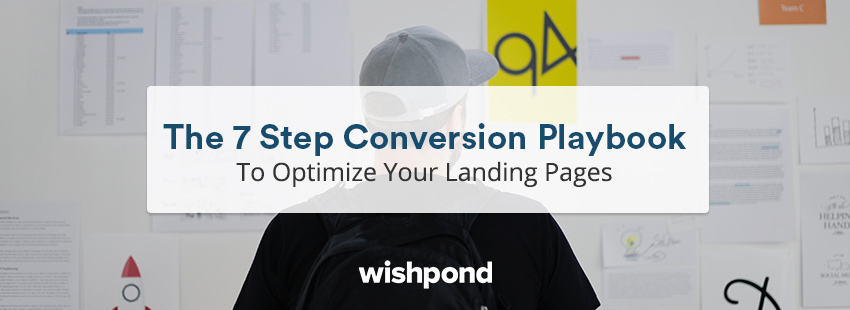When it comes to optimizing landing pages, there’s one piece of the puzzle that usually leads to the biggest wins for our clients.
It isn’t the color of the buttons or using the keywords in the headline.
It also isn’t the length of the page or the background image we use.
What actually moves the needle the most is optimizing landing pages using the insights we have gathered from performing conversion research.
This is something which we do as a CRO agency prior to optimizing any landing page.
Once we apply what we have found during our research stage, we’ll usually see the biggest lifts in conversion rates.
Conversion Research
Conversion research usually takes two different forms. The first being Quantitative analysis, where we are using analytics data to see if we can spot any anomalies.
But Quantitative analysis can’t always be performed on all landing pages. It requires a minimum volume of traffic and conversions to make statistically significant decisions.
Our second reach stage is Qualitative analysis.
This where we are a lot more user-centric with our research to try to find out what customers want and what’s holding them back.
We’re doing things like usability tests, watching user recordings and interviewing customers.
I have some expert advice when it comes to your conversion research.
Wait for it….
Qualitative analysis is where you will find the biggest opportunities for your landing pages.
That’s right, I said it.
By finding out what barriers are preventing your customers from purchasing, you can address these pain points on your landing pages to try and convert more users into customers.
In this article, I’m going to walk you through how to quickly optimize your own landing pages using mostly qualitative analysis to uncover opportunities.
Here’s what we’re going to cover in this article :
- Perform a Relevancy Test
- Watch User Recordings
- Usability Testing
- Interview Your Sales Team
- Interview Your Customers
- Form Optimization
- Analyze Google Analytics Data
Let’s get started.
1.Perform a Relevancy Test (aka The Blue Running Shoes Test)
There’s nothing more annoying than arriving on a website after clicking on a link from a search engine, that takes you to a page that’s completely unrelated to what you were expecting.
This doesn’t apply to just you and I either, the rest of the world actually feels the same too.
What we’re talking about here is relevancy. How relevant is the landing page to what the user was expecting when they arrive?
The more relevant you can make a landing page to what the user is looking for, the higher the probability you will have turning that user into a customer.
To perform a relevancy test, you will need two pieces of equipment – yourself and your computer.
Next, you need to take your ads that receive the most amount of traffic (image, video or text) and map out the landing page that each of them is sent to.
*If you don’t use paid ads, you can simply use your organic links and map them out to your landing pages.
Then you need to work your way through each one and have a look at how relevant you think the landing page is to the ad the user is seeing.
At Conversion Hut, we call this the ‘Blue Running Shoes Test’.
Apart from being a cool name, we use this as an early indicator when evaluating landing pages.
Let’s say a user searches for ‘blue running shoes’ on their search engine.
For a user to be confident that they have arrived on a potential website to purchase from, that page needs to be primarily focused on blue running shoes.
The user shouldn’t have to filter anything, click deeper into the site or sort anything whatsoever. They should arrive on that page and think “Hey, these guys literally only sell blue running shoes!!!”.
If you can nail the blue running shoes test, you’re in great shape for the user hanging around.
Doing this effectively won’t just help your landing page optimization, but also your PPC management too. Higher conversion rates usually lead to much lower cost per conversions.
Here’s some relevancy examples (Good and Bad)
Example 1 : Bad

As you will be able to see, the ad is advertising CRM Software for Enterprises. So in the user’s mind before clicking the ad, they’re expecting to see a landing page related to Enterprise CRM.
Instead, they are sent to a landing page which is discussing CRM applications.
Example 2 : Bad

This time, we expect to see a landing page related to ‘Sales Management Software’ but instead users are being sent to a landing page where the copy is tailored around CRM software to help with sales.
Again, there’s a message mismatch. A user is expecting one thing and seeing something different.
Example 3 : Good

Hooray!
We have a user expecting to see flight deals to Australia and that’s exactly what they are getting. The landing page is completely relevant to what the user is expecting.
Example 4 : Good

MailChimp knocked this one out of the park.
The image on the landing page is the same one used in the banner and the messaging is nearly identical from the ad to the landing page.
There’s no doubt that this page is relevant to what the user is expecting.
2. Watch User Recordings
Next up we have user recordings. If you don’t know already, this is when the sessions of users are recorded whilst they use your website.
These recordings can then be viewed to assist with conversion optimization.
It might sound a bit weird at first, but it’s an awesome tool to have in your artillery.

The main benefit of using this is that you can find out where users are running into issues whilst using your landing pages or website.
For instance, we may find from our Google Analytics reports (discussed in a minute) that users on mobile devices have a high abandonment rate.
What we can do is view recordings of user sessions segmented by mobiles devices. From here we can look for any patterns or common issues that users are facing.
Or we may find from watching the videos that there’s a form issue we didn’t know about, we can then jump straight into our landing page code and fix it. We should then see an instant lift in our conversion rate.
Hotjar is a great tool to start with when it comes to starting out with user recordings. They also have a free trial so you can “dip your toe in” without needing to spend any money.
It’s super effective. Well known UK retailer Matalan, saw a huge 900% ROI when implementing after implementing it.
3. Usability Testing
Usability testing is the big brother to user recordings.
The concept is similar as we’re observing users whilst they are using our landing pages.
However, this time we are asking the participants to perform specific tasks.
Doing this lets us measure if they can complete the tasks successfully or whether they run into difficulty.
The biggest insights here is that the test participants will speak out loud whilst they are doing the test.
They’ll let you know what they are expecting to happen, when they run into difficulty, what they like and what they dislike etc.
Testers are usually recruited from the platform so you don’t have to worry about that. Once you set up your test you can specify your tasks that you want the user to do.
Here’s some example questions :
- Find product x and complete a purchase.
- Book an appointment for next Tuesday at 3 pm.
- Search for ‘home insurance’ on Google and request quotes from two other companies.
One point to make here is to try and not be too subjective. Don’t ask the user if they like your website, because it’s not going to provide you with anything actionable.
Instead, try to find common usability issues that may be causing people to abandon your landing page.
There’s plenty of tools to help you with Usability Testing, here’s just a few:
- UserTesting.Com
- WhatUsersDo.com
- TryMyUI.com
- Lookback.IO
We had an instance at Conversion Hut not so long ago where we couldn’t quite get the spike in their conversion rate that we would normally want to see.
After performing an initial round of usability testing, nothing was indicating that there were any issues.
So we did another round. But this time we asked the participants to compare 3 other companies that sold the same service.
We found that when looking for this particular type of service, users wanted much more information as it was quite complex.
We addressed these findings, tested a long-form landing page with much more content and we were able to see almost a 20% lift with the new version.
4. Interview Your Sales Team
Now is when things are going to get really interesting. I bet you didn’t think that interviewing your sales team was going to help you increase your conversion rate?
Well, it will.
As I’ve mentioned already, a huge part of optimizing landing pages is addressing the common objections or barriers for your customers.
Why?
If we can address their pain-points on our landing pages, then this should lead to persuading more users to complete the desired action.
The reason we want you to interview your sales team is because they are constantly speaking to your customers.
So they will know the common objections that they have.
It’s straight from the horse’s mouth.
Here are some example questions that you can use:
- What are the top 3-5 objections from potential customers?
- What do you answer to persuade users to buy?
- Are there any particular areas of (insert service or product) that people don’t understand?
What aspects of (insert service or product) do people like the most and the least?
Next, we use these insights and try to incorporate them into our landing page.
Some may be no-brainers that you can go ahead and implement straight away. Whilst others may need some planning (more on this shortly).
5. Interview Your Customers
So we’ve talked to our sales team. Now we’re going to talk to our existing customers. People that have actually parted with money and purchased what it is your selling.
The reason we want to do this is to find out two things:
- The reasons why they decided to buy from you.
- The reasons why they nearly didn’t buy from you.
By finding out why users buy from you, you will find out what’s matters the most to your customers.
These are the people the exact people that you want to persuade more of, so it makes sense to find out what they want.
Once we know this, we can use this to draw more emphasis to the most important aspects.
Additionally, we also want to know the reasons why customers nearly didn’t buy.
If we find out why people nearly went elsewhere, we can hopefully address this and lower the number of users who are abandoning the landing page for the same reason.
When we do this for clients, we sometimes run into difficulty getting responses from customers to our survey. Usually, an incentive works well, like a $20 Amazon voucher or a month’s free use of your product.
6. Form Optimization
Now we’re going to move into Quantitative research techniques.
If your landing page is using a form to collect leads then you can use form analytics to collect data to find potential improvements that can be made to them.
We can see data points like :
- The number of drop-offs from a specific field
- The amount of time spent in each field
- Common fields causing validation issues
And it works. Capital One managed to increase their form completions by 24% over a 3 month period by implementing form analytics and optimization.
Form optimization can be done using Google Analytics but we like to use a tool called Formismo as it’s so easy to set up and it comes with a range of powerful reports.
7. Analyze Google Analytics Data
Finally, we have the grandfather of Quantitative Data and that is Google Analytics (GA).
GA contains a wealth of data that can be used to optimize your landing pages.
Knowing where to start can be a bit daunting if you don’t know what you are doing. Don’t worry though, there’s some actionable tips coming right up!
Our primary aim here is to find potential issues with the landing page that may be causing users to abandon the page.
First of all, you want to create a new user segment for users who have arrived on the landing page you’re working on and apply it to your data. If you want to know how to do that, check out this post.
Once that’s set up, we can start taking a look at the reports. Here are some of the best ones to start with :
1) Conversion Rate By Device – (Audience -> Mobile -> Overview)
Here you should see data for Desktop, Mobile, and Tablet as well as the conversion rates.
Don’t be too worried if you see a difference between mobile and desktop of up to 30%. Any more than that and you really we want to be taking a closer look for cross-device issues.

Mobile isn’t looking good at all here, we’re going to need to take a closer look at that.
2) Conversion Rate By Device Browsers (Audience -> Mobile -> Overview)
What we would like to find out here is if there any particular browsers causing cross-browser issues on different devices.
By doing this, we can quickly see if there’s anything that needs our attention.
In the same Device report used above, we want to add the secondary dimension of ‘Browser’ and see if anything jumps out at us.
If it does, we can go to the specific browser report to dig a little deeper (Audience -> Technology -> Browser & OS)
Here are some more extremely insightful reports you should take a look at :
3.) Conversion Rate By Operating System (Audience -> Technology -> Browser & OS – Then change primary dimension to Operating System).
4.) Conversion Rate By Screen Resolution (Audience -> Technology -> Browser & OS – Then change primary dimension to Screen Resolution).
5.) Conversion Rate By Age (Audience -> Demographics -> Age).
6.) Conversion Rate By Gender (Audience -> Demographics -> Gender).
7.) Conversion Rate By Location (Audience -> Geo -> Location).
If you work your way through the above reports you can start to document your findings and spend time investigating them more. You may also find opportunities to optimize your marketing campaigns based on what you find too!
One thing to remember when you’re working with GA is that you don’t want to make business decisions using data that isn’t accurate.
You will always want to make sure that you have a reasonable volume of visits and conversions before you start making any conclusions.
Next Steps
I wouldn’t suggest that you just go ahead and implement everything you’ve found immediately on your landing pages, unless you know for certain that it’s going to lift your conversions (i.e. a bug fix).
The next steps once you have done all of your research is to document it (we like to use excel) and then prioritize each finding based on its potential impact on your conversion rate.
Work your way through each insight systematically and if your traffic allows for it, start running some a/b tests.
Summary
Hopefully, by know you understand the wealth of insights that you can collect by performing conversion research.
We’re moving away from just guessing what to do to increase your conversion rate towards an experimentation mindset. Where instead of guessing, we are using real-life data to optimize.
I hope you’ve enjoyed this guide and please feel free to reach out if you have any questions or comments!
About the Author
Dale Broadhead is the Founder of Conversion Hut, a PPC & CRO marketing agency based in the United Kingdom. They help companies drive high-quality traffic and assist their clients to increase their conversion rates.

